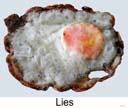Pabulum – 2005
Pabulum n. Food for the mind. Insipid intellectual nourishment
From pornographer to food stylist.
Other than nutrition and ‘taste’, food is closely related to bodily functions. Food is to eating, what humour is to laughter. These images of food, presented as archetypes, spring directly from my work on body parts, specifically, mouths, lips and tongues. Our attitudes to food are deeply subjective and we have strong opinions, likes and dislikes. This is an interest in food disorders, addictions and preference. There exists a primordial psychological relationship with food and, like sexuality, our attitudes and ‘hang ups’ are formed at an early age. And, as with sex, food is sensual, even visceral. The celebratory aspect of this is the feast, the medieval feast days and comic festivals – carnival, the people’s expression of all that was not official.
Images of food constitute a major genre of advertising and may be considered obscene in ways comparable with pornography, with their hard and soft core, glamour photography and photographs of readers wives. As Frederick Kaufman pointed out in Harper’s Magazine, “TV cooking builds to an unending succession of physical ecstasies, never a pile of dirty dishes.” I prefer the ‘readers wives’ photographs of food, the amateur over the professional – raw, vulgar and awkward (good, bad photography).
This collection of images is a site specific installation that parallels similar images in other eateries, such as the light box images of burgers in McDonalds. However, my fare is not on the menu at Browns (cafe/bar) and it is unlikely that my images would stimulate the appetite. The sets of images, with text and lists, represent a collision and confusion of categories. The words relating to the food were randomly selected, but were rejected if the juxtaposition suggested a particular meaning or relationship. If the words made sense I did not use them. However, the broad themes deal with national identity and culture. Food is political and central to national and ethnic identity, but national identity, along with national character, is a myth, a construct.
National identity is propped up by a false yet reassuring sense of the continuity of tradition. Our traditions are rarely as old or as ethnically harmonious as ‘tradition’ might imply. Traditions are inventions and everything has a history. Fish and chips, for instance, was introduced to the East End of London by Jewish immigrants in the 19th century. Curry has been a part of the English diet for longer than fish and chips and even the macho eating of hot vindaloo features in Thackeray’s Vanity Fair. Morris dancing – the seminal English folk dance – was originally introduced into England from Moorish Spain and Islamic North Africa by British sailors. Interestingly, these are the same origins as the Spanish Flamenco. Whilst batter puddings were also known in the south of England as well as in Yorkshire, ketchup is derived from the Chinese sauce ke-tsiap, Haggis was eaten in ancient Greece and Rome, Whiskey was invented in Italy and the kilt is Irish (the word kilt being Danish). The traditional British Christmas was a Victorian invention. The Christmas tree has its pagan origins in Germany and was made popular in Britain by Prince Albert. And the turkey is an American!
Our assumptions about what is quintessentially British or even European are usually erroneous. British culture stems from a distant and diverse past and is the product of a multiplicity of cultures and traditions brought about by invasion, trade, theft, colonialism, Empire and immigration.
The conceit of my images of food is that they are also in the tradition of 17th century still life painting, of fish and fowl, with the ‘vanitas’ as the half eaten meal, (Fashion). John Berger referring to Still Life with a Lobster by De Heem, stated “Here the edible is made visible. Such painting is a demonstration of more than the virtuosity of the artist. It confirms the owner’s wealth and habitual style of living”. Pabulum runs counter to this aristocratic function.
Bon appétit!
John Yeadon, September 2005

